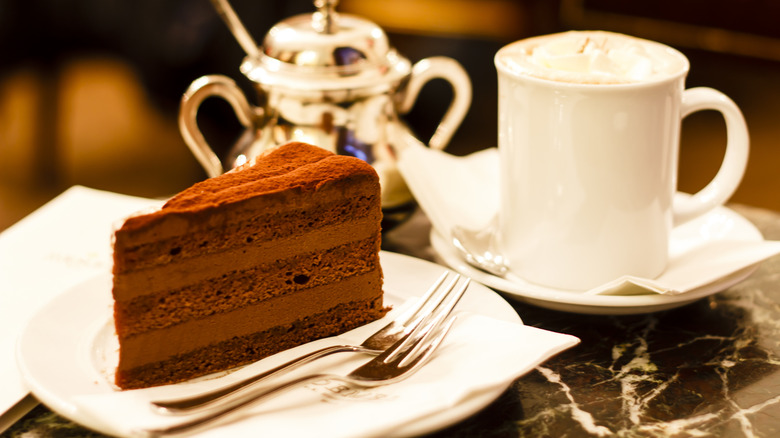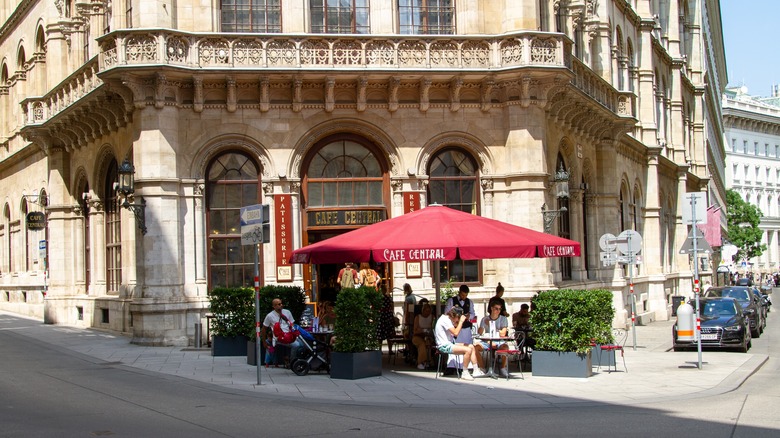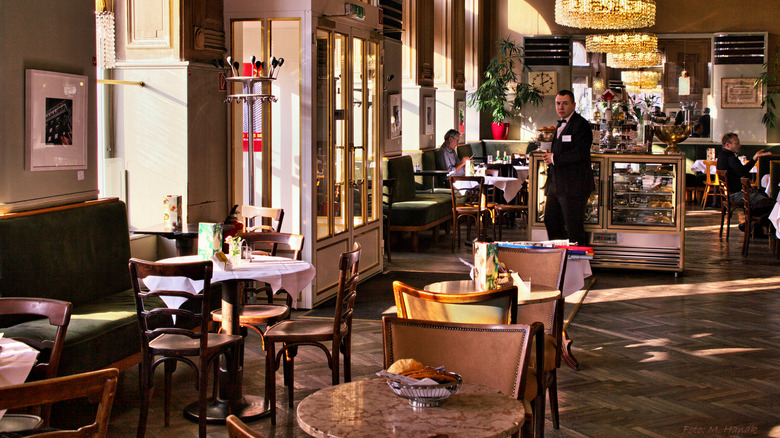How Vienna Became A Historical Epicenter For Coffeehouses
When it comes to the history of coffee, certain cities have great significance — and Vienna, Austria's capital, is undeniably one of them. Today, Vienna is well-known for its coffeehouse culture, with about 600 coffeehouses, all steeped in tradition and rich history. But how did Vienna become a historical epicenter for coffee culture? It mostly comes down to the city's location — from 1867 to the early 1910s, it was the joint-capital of the Austro-Hungarian empire. This meant that, as a cultural melting pot within Europe, it was booming with a mix of ideas. By 1900, there were 1.7 million inhabitants, and it was among the most populated cities in Europe. All those people needed somewhere to socialize and learn about current events — and so the coffeehouse rose in popularity.
The start of Viennese coffeehouse culture dates from 1685, when Armenian businessman Johannes Deodato established the city's first coffeehouse. A few decades later, in 1720, Café Kramer began offering newspapers for their customers to read, which really led to what Viennese coffee culture evolved into: finding out what was going on in the city and reading world news. Gossip and information was also shared through word of mouth as Vienna's coffeehouses became places for people to socialize.
While they began as men-only spaces, women were finally permitted entry to coffeehouses in 1856, making them a truly communal space. By the 20th century, coffeehouses had become the go-to meeting places for people of all trades to exchange ideas and discuss politics.
The evolution of the coffeehouse in Vienna
Coffeehouse culture remaining a mainstay in Vienna is more of a feat than you might think. After their creation in the 17th century, the business model faced hardships from 1803 to 1813 due to Napoleon blocking Austria's trade with England. This resulted in coffee beans becoming increasingly expensive and hard to come by. Once the embargo ended, coffee began freely flowing once again — including into Vienna's coffeeshops.
Coffee continued to play a major role in Vienna's culture over the years, eventually leading to the establishment of the "Klub der Wiener Kaffeehausbesitzer" ("Club of Viennese Coffeehouse Owners"), which was founded by a coalition of coffeehouses in the city in 1956. The club members participate in programs to learn more about coffee and promote the cultural significance of coffeehouses. Members are considered to be the city's representatives when it comes to anything related to coffeehouse culture.
Then, during the 1950s, coffeehouses began to lose favor due to the rise of espresso bars, which led to traditional coffeehouses either having to adapt or close, as many unfortunately did. Additionally, the new popularity of television now made it easier to receive your news from home — sharing news had previously been a major reason why people gathered in coffeehouses. Luckily, many coffeehouses managed to stay open. Now, decades later, they capitalize on the charm and nostalgia of original coffeehouses and their former importance to the city.
What to expect from a Vienna coffeehouse
The interior architecture is one notable aspect of most Viennese coffeehouses. They are typically spacious, featuring high ceilings, marble table tops, and chandeliers. The wait staff are dressed more for a fine-dining restaurant than a coffeehouse. And guests are usually encouraged to stay as long as they want — even if they only order one drink.
And what kind of drinks are served at a coffeehouse in Vienna? A cappuccino will definitely be on the menu. The origin of the drink comes from none other than Vienna itself. According to James Hoffmann, in his book "The World Atlas Of Coffee," the cappuccino (whose name derives from kapuziner), was created in Vienna in the 1800s — except it was a bit different than it is now. Then, the kapuziner consisted of a drip coffee mixed with sugar, egg yolks, and cream. Over time, it evolved into the version we know today — equal parts espresso, foamed milk, and steamed milk — which you will find in modern-day Vienna coffeehouses. You can usually order a modern kapuziner, too, which is coffee topped with whipped heavy cream.
Other drinks include the melange, which is similar to a cappuccino but with less espresso; the einspänner, which is a dessert-like drink served with whipped cream and powdered sugar on the side; and the Biedermeier, which is a black coffee with whipped cream and apricot liqueur. Most coffeehouses also serve food, including delicious Viennese cakes.


